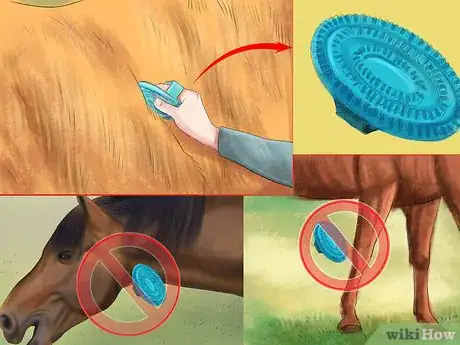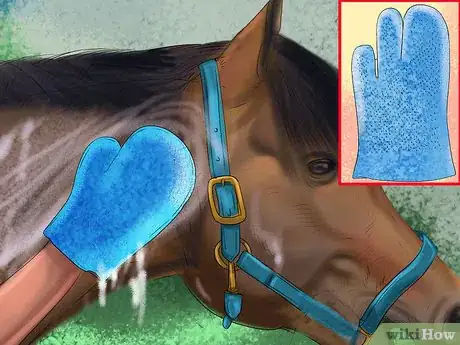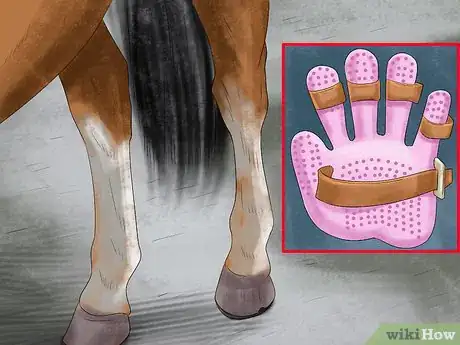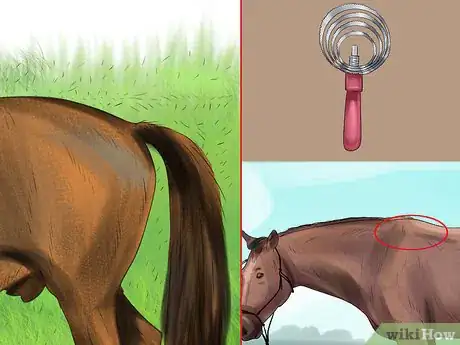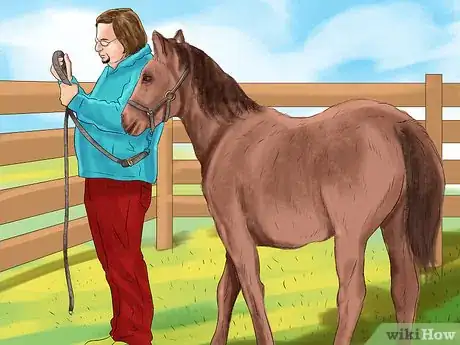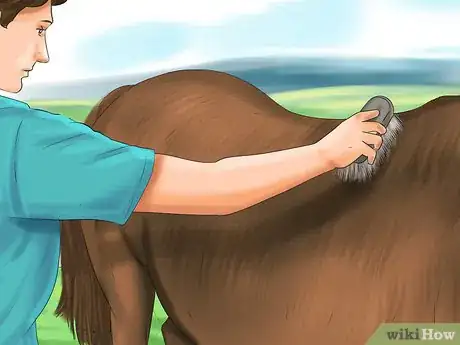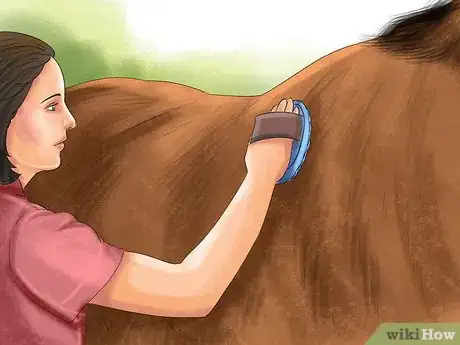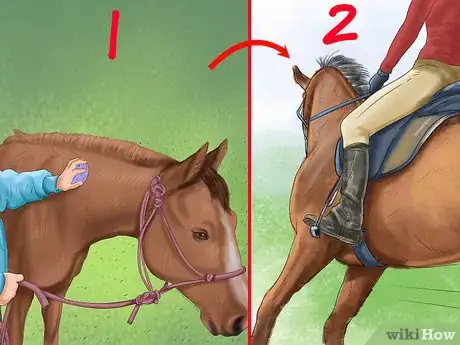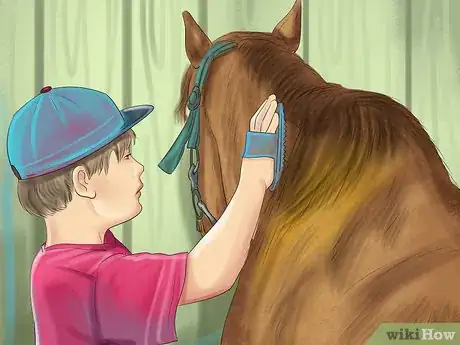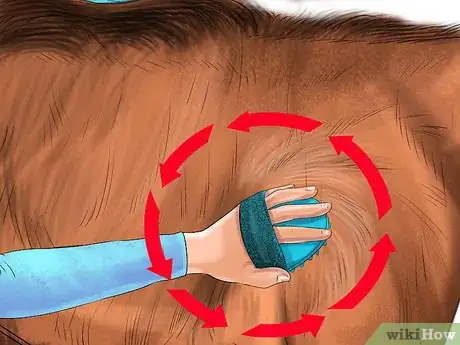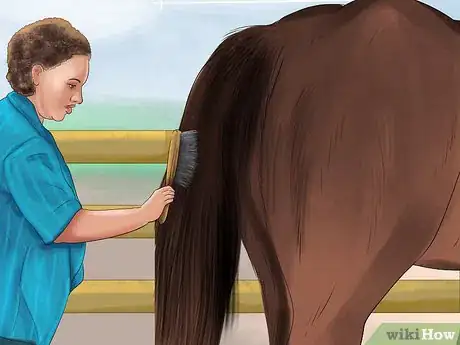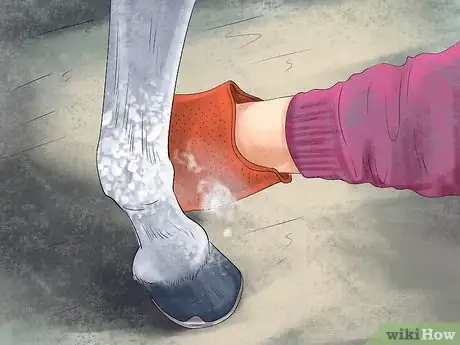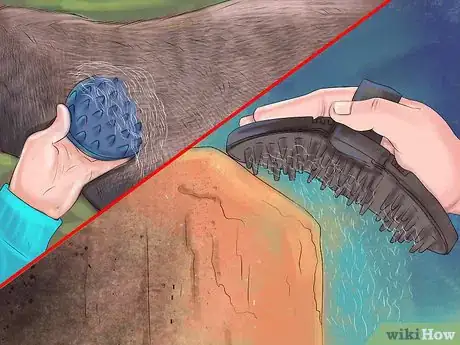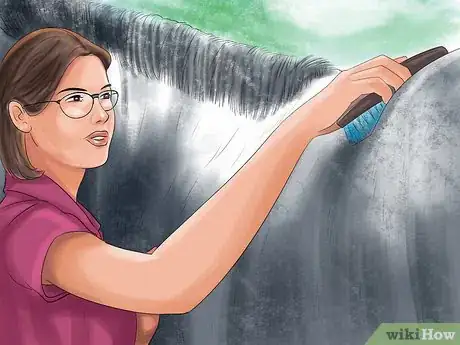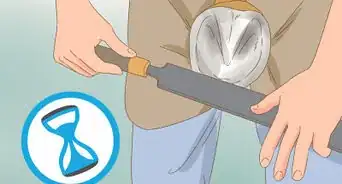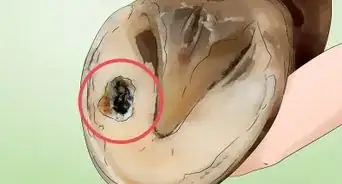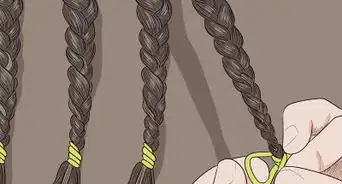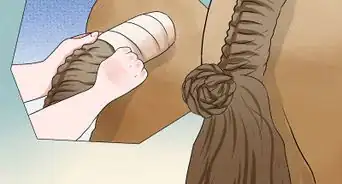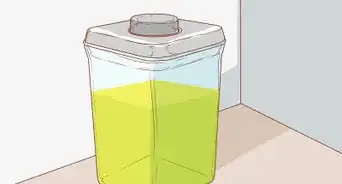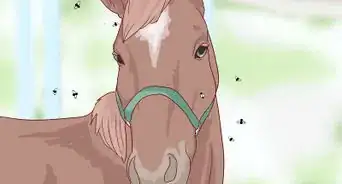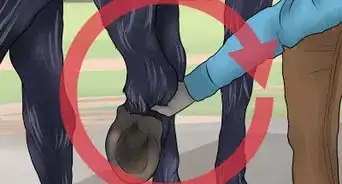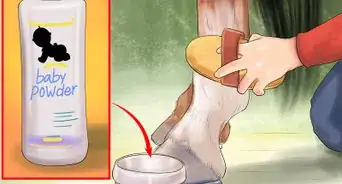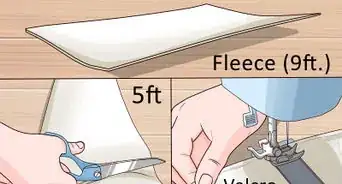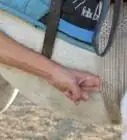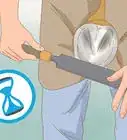This article was co-authored by Pippa Elliott, MRCVS. Dr. Elliott, BVMS, MRCVS is a veterinarian with over 30 years of experience in veterinary surgery and companion animal practice. She graduated from the University of Glasgow in 1987 with a degree in veterinary medicine and surgery. She has worked at the same animal clinic in her hometown for over 20 years.
This article has been viewed 34,106 times.
A curry comb is a type of horse grooming brush that removes shedding hair, scurf, and sweat from a horse’s body. It also loosens caked mud and dirt. Curry combing your horse is an important part of grooming your horse and maintaining its health and wellbeing. But there are different types of curry combs and methods for using them on your horse. By choosing the best types of curry comb and properly massaging them on your horse’s body, you can easily use a curry comb on your horse.
Steps
Finding the Right Curry Comb
-
1Go with a rubber curry comb. The workhorse of the curry combs, a rubber version comes in different colors, sizes, and nub depth. You can also choose different flexibilities depending on what you and your horse like. Finding one or two different curry combs to use on your horse will help keep it clean, help blood circulation in the skin, distribute oils, and give your horse’s coat a nice shiny glow.[1]
- Be aware that rubber combs shouldn’t be used on a horse’s face, ears, or legs.
- Throw these in the wash rack for bath time if you like.
-
2Get a curry or pimple mitt. Another version of the curry comb you and your horse might like is the curry mitt or pimple mitt. These pimpled gloves are great to use on sensitive horses as well as sensitive body parts like faces, bellies, and lower legs. You can also use them on other body parts if you like.
- Fold your curry mitt in half to get into your horse’s nooks and crannies. For example, you could use this in the horse’s “armpits” to clean out sweat stains and massage the area.
- Throw curry mitts into the wash rack for bath time if you like.
Advertisement -
3Use a jelly mitt. Like curry mitts, jelly mitts are also very versatile. They generally are different sized pimples or nubs on each side for different parts of your horse’s body. Unlike other curry combs, you can also use jelly mitts on a horse’s lower legs.[2]
- Try using a jelly mitt to loosen hair on saddle pads. The stiffer nubs are also good to remove dried poultice from your horse’s lower legs.
-
4Consider specialty curry combs. In addition to standard types of curry combs, there are different shapes, textures, and designs. These are usually for specific body parts or to do things like massage a horse’s fascia and muscles.[3] If your horse has specific physical needs or you even just want to give it a treat with something like a massage curry comb, keep one or two of these handy.[4]
- Consider any problems or specific health needs your horse has. Does he or she have tight muscles from training for competitions? Try a cross fiber groomer to help loosen up your horse’s fascia and muscles. You could also try a specialty mitt for sweat stains if the horse trains frequently or lives in hot climates.
-
5Be cautious with metal curry combs. Some curry combs are made of hard and inflexible metal that scrape up hair and dirt well. However, they can be too harsh on a sensitive horse and shouldn’t be used to brush any bony areas like the shoulders, hips, and legs. Consider using a metal comb in conjunction with a plastic or rubber curry comb for the best results.[5]
- Use the metal comb on your horse only if it likes it. Otherwise, consider using a metal comb to scrape hair and sweat from saddle pads or to clean rubber or plastic curry combs.[6]
- Be aware that metal curry combs don’t do well in water, so you may not want to use them at bath time.
Making Your Horse Comfortable
-
1Tie up your horse. Before you start curry combing your horse, tie it up in a safe place. Leaving your horse loose in a stall or without a halter can leave you without any control if the animal tries to turn around or escape from you. Consider giving your horse a treat for allowing you to tie it up. This may also help it stay calm during the curry combing session.
-
2Hold the curry comb properly. Grasp the handle and use your thumb and fingers to hold the comb firmly. If you are using a mitt, slip your hand into it completely and ensure that it won’t slide off during your combing.
- Make sure any straps on the curry comb are secure and not broken to ensure optimal use. The same goes for the nubs on plastic combs. Broken parts may hurt you or your horse.
-
3Remember to be gentle. From the way that you curry comb your horse to how you move around the animal, remember to use gentle movements. This can prevent harming or startling your horse and ensure a pleasurable experience for both of you.[7]
-
4Get your horse used to curry combing. If your horse is young or needs more frequent cleaning, it’s important to give your horse time to get used to it. Providing your horse with positive reinforcement and gentle handling can help you more easily get through a curry combing session and teach your horse to love getting clean.[8]
- Try and curry comb your horse any time you ride it. This gets it in the habit of being groomed and can help him or her stand still for longer grooming sessions or even to get new horseshoes. It can also help you detect health problems.
- Give your horse a treat at the beginning and/ or end of a curry combing session. Offer the horse a lot of praise for good behavior. Make sure to take your time so that your horse doesn’t sense any urgency or irritation. These behaviors can help your horse get used to curry combing and associate it with positive feelings.
-
5Figure out your horse’s favorite comb. Just like humans and other animals, horses often love the feeling of being groomed. This is especially true if you take your time to lovingly groom your horse. However, you may notice that your horse reacts differently to certain combs, which can cue you into what he or she prefers in terms of the curry comb. Try and focus on this comb to help your horse enjoy the grooming process.
- Notice if your horse leans into you, which is a sign that he or she is enjoying that particular comb.
- Look to see if your horse’s ears are turned out to the side, which is a sign that he or she is relaxed. Likewise, a dropped head can also indicate relaxation.[9]
Combing Your Horse’s Body
-
1Move the currycomb in circular motions. Starting at the top of your horse’s neck, use the curry comb in circular motions on your horse. Work with the direction of the horse’s hair as if you were giving the animal a massage.
- Press firmly but gently when currycombing in the direction of the hair. Use lighter pressure if you’re going against the horse’s hair. Don’t be surprised if your horse leans into the curry comb because it likes the feeling!
- Use caution when going back and forth in a scrubbing motion. Some people suggest not using a scrubbing motion while others think it’s acceptable if done gently.[10]
-
2Comb over the rest of the body. Work your way around the rest of the horse’s body, taking care around bony and sensitive areas.[11] Avoid using the curry comb on the head and mane, lower legs, or other especially sensitive areas for now.[12]
- Check to see that the curry comb is bringing up dirt and dead skin to the surface of the coat. If none is visible, consider going over the area again to prepare it for removal with a body brush.[13]
- Use a different curry comb, such as a jelly mitt or pimple mitt, if your horse appears sensitive to the plastic curry comb.
-
3Pay special attention to the back and girth. A horse’s stomach, or girth, and back often collect the most sweat and dirt. Make sure to focus a significant part of your time to curry combing these areas.
- Remember that the girth is often very sensitive. Consider switching to a jelly or pimple mitt to remove sweat and dirt. If this doesn’t effectively bring up hair, dirt, and sweat, try using a rubber comb with deeper nubs.[14]
- Check the areas where your horse’s saddle sits on its back. Make sure to give this area a lot of attention, too, since sweat and hair can build up underneath the saddle.
-
4Go over bony parts gently. A horse’s spine, elbows and legs are very bony. Because of this, they require special care when curry combing them. Use a pimple mitt, jelly mitt, or specialized mitt to curry comb these delicate areas.[15]
- Use the same firm but gentle pressure to curry comb the spine, legs, and elbows. Don’t brush too deeply on these parts of the horse’s body as they don’t have as much muscle and fat as places like the neck or girth.
- Brush sensitive areas in the direction of the horse’s hair, just like you would do with other parts. Remember to avoid using a scrubbing motion, which may be especially uncomfortable on sensitive or bony areas.
- Be especially careful when curry combing the horse’s legs so that it doesn’t kick you. Use the most gentle pressure here so that you don’t startle the horse.
-
5Comb the face. Unclip your horse from the lead or where you’ve tied it up so that you can effectively curry comb its face. Hold the curry comb in one hand and your horse’s face in another as you gently work your way around the face.[16] Make sure to avoid the delicate eye area and the horse’s mane.
- Work your way from the horse’s neck to the jaw, nose, behind the ears and brow band. Pay special attention to these areas because remaining dirt can cause discomfort under the horse’s bridle.
- Put the head collar back on or tie up the horse again so that you can finish your curry combing session.
- Use a regular or body brush to comb the mane. Dampen it with some water to remove excess debris and keep the mane flat.
-
6Empty the curry comb. You may find that the curry comb fills up with hair, dirt, dried mud, or sweat as you brush your horse. Occasionally “emptying” the curry comb by banging it against a hard surface can help you more effectively groom your horse.
- Empty your mitt only if necessary. In most cases, debris will simply fall out of mitts without banging it against anything.
-
7Brush off debris. Use a body brush in a flipping motion to remove all of the hair and dirt brought up through curry combing. Make sure to start at the neck and work your way all over the horse’s body. This can make your horse’s hair supple and shiny.[17]
- Make sure to brush in the direction of the hair. Clean out the brush every few strokes by combing the rubber curry comb with a metal version.
Warnings
- Avoid using rusty equipment of any kind on your horse. A rusty curry comb used too harshly or over an open sore can cause tetanus.⧼thumbs_response⧽
References
- ↑ http://www.proequinegrooms.com/index.php/tips/grooming/back-to-basics-the-curry-comb/
- ↑ http://www.proequinegrooms.com/index.php/tips/grooming/back-to-basics-the-curry-comb/
- ↑ http://www.proequinegrooms.com/index.php/tips/grooming/back-to-basics-the-curry-comb/
- ↑ http://www.horsechannel.com/horse-keeping/grooming-tools.aspx
- ↑ http://www.horsechannel.com/horse-keeping/grooming-tools.aspx
- ↑ http://www.proequinegrooms.com/index.php/tips/grooming/back-to-basics-the-curry-comb/
- ↑ http://www.equestrianandhorse.com/care/grooming/introduction.html
- ↑ http://www.thehorse.com/articles/10028/grooming-your-horse-deep-down-clean
- ↑ http://equusmagazine.com/article/how-to-read-your-horses-body-language-8577
- ↑ http://www.equestrianandhorse.com/care/grooming/introduction.html
- ↑ http://www.equestrianandhorse.com/care/grooming/introduction.html
- ↑ http://www.equestrianandhorse.com/care/grooming/introduction.html
- ↑ http://www.equestrianandhorse.com/care/grooming/introduction.html
- ↑ http://www.equestrianandhorse.com/care/grooming/introduction.html
- ↑ http://www.equestrianandhorse.com/care/grooming/introduction.html
- ↑ http://www.equestrianandhorse.com/care/grooming/introduction.html
- ↑ http://www.equestrianandhorse.com/care/grooming/introduction.html
